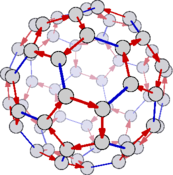We have looked at the character tables for the abelian groups of order 8, ℤ₈, ℤ₄✕ℤ₂ and ℤ₂✕ℤ₂✕ℤ₂. Because they are abelian, each has 8 conjugacy classes and their character tables are distinct. With the two non-abelian groups, D4 and Q, there are five conjugacy classes. The trace of the identity element is the dimension of the irreducible representation, and the sums of the squares of these number must equal 8. There is only one way to do this, 1² + 1² + 1² + 1² + 2².
Here are the conjugacy classes for Q.
Class #1: 1
Class #2: -1
Class #3: i and -i
Class #4: j and -j
Class #5: k and -k
And here are the conjugacy classes for D4.
Class #1: R0°
Class #2: R180°
Class #3: R90° and R270°
Class #4: M0° and M90°
Class #5: M45° and M135°
The entries of the one dimensional representations must be numbers on the complex unit circle, but the two dimensional numbers are the traces of the 2✕2 matrices. In 2x2 matrices, the 180° rotation and the matrix representing -1 are the same.
-1 0
0 -1
The trace here is -2.
Let's start making the table for Q.
1 -1 i -i j -j k -k
1 1 1 1 1 1 1 1
1
1
1
2 -2
All the conjugates are negatives of one another, so for the one dimensional representations f(-1) = 1.
1 -1 i -i j -j k -k
1 1 1 1 1 1 1 1
1 1
1 1
1 1
2 -2
To make all the one dimensional representations orthogonal to one another, we send two of the conjugacy classes to -1 and the last class to 1.
1 -1 i -i j -j k -k
1 1 1 1 1 1 1 1
1 1 1 1 -1 -1 -1 -1
1 1 -1 -1 1 1 -1 -1
1 1 -1 -1 -1 -1 1 1
2 -2
Let us call the traces of the two dimensional conjugacy classes a, b and c.
1 -1 i -i j -j k -k
1 1 1 1 1 1 1 1
1 1 1 1 -1 -1 -1 -1
1 1 -1 -1 1 1 -1 -1
1 1 -1 -1 -1 -1 1 1
2 -2 a a b b c c
To make the two dimensional representation orthogonal to the one dimensional representations, we have these four equations.
2a + 2b + 2c = 0
2a - 2b - 2c = 0
-2a + 2b - 2c = 0
-2a - 2b + 2c = 0
Adding the first two equations together, we get 4a = 0.
Adding the first and third, we get 4b = 0.
Adding the first and fourth, we get 4c = 0.
1 -1 i -i j -j k -k
1 1 1 1 1 1 1 1
1 1 1 1 -1 -1 -1 -1
1 1 -1 -1 1 1 -1 -1
1 1 -1 -1 -1 -1 1 1
2 -2 0 0 0 0 0 0
The logic for filling in the D4 table is the same, because yet again, each element that has a conjugate is the negative of that conjugate, where -1 is represented by R180°, which commutes with everything.
Next, we will look at other small non-abelian groups to determine their character tables.


